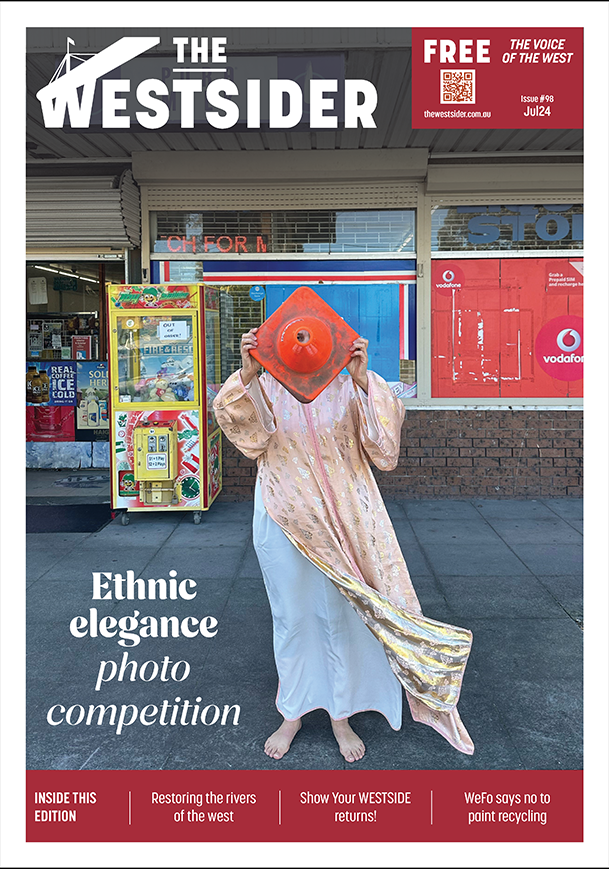By Peter Dewar
At a time when our planet is on the boil, Elon Musk fans say the electric-powered Tesla is a game-changer. It’s not the first occasion we’ve looked to the automobile for a brighter future. Early last century, Aussie innovators and venture capitalists alike joined the race to build an Australian-made vehicle for a nation falling in love with the car.
Enter Tom Buckingham. His ‘wheel with springs’ was set to change the bone-jolting experience of travelling on solid tyres. Buckingham even patented his invention overseas. Of course, it was Dunlop’s air-filled tyre that revolutionised motoring. Though this wasn’t the last we’d hear of the entrepreneurial engineer from Mildura.
Buckingham relocated to Footscray with his wife in the mid-1920s. ‘He was fanciful… clever’, says Scott Garnett, an amiable, retired teacher, who told the tale of Tom Buckingham and his Footscray automobile to a packed room at a recent Footscray Historical Society event.
The story speaks to an energetic, 20th century manufacturing hub, an inner west unrecognisable today. Scott takes a wide-eyed audience back to an era when a car could be made in Footscray from components sourced at nearby factories. Equally as fascinating is his research journey. A labour of love, possibly inspiring other budding historians to embark on a similar adventure.
Buckingham partnered with Alfred Thomas Ward, a pastry chef, to build an automobile for mass production. ‘Two blokes in a shed in Buckley St [Seddon] made a car. That blows me away,’ says Scott, clearly animated.
Initially called the Hamard, a combination of the founder’s surnames, the vehicle was shortly rebranded the Buckingham. And, in 1933, a prototype of the chassis was displayed at the Melbourne Motor Show with a working coupe model exhibited at Melbourne’s Royal Agricultural Show.
Scott flicks up a long list of company names on an overhead screen — manufacturers of parts for the Buckingham, a stark reminder of the dramatic loss of inner west manufacturing. To think, Footscray was once compared to a famous English industrial city, and dubbed the ‘Birmingham of Australia’.
‘On their doorstep were all these organisations,’ Scott says. ‘Mephan Ferguson [manufacturer of the car’s chassis] was a huge iron works that made bridges all around Victoria and put water into goldfields at Kalgoorlie. In 1897, they had offices in Sydney, Perth, London, and Footscray. Not bad out of Gordon Street.’
The automobile’s engine was cast by United Engineering and Malleable Co.. Other nearby firms, which played a part included: Richardson Gears, Nettlefolds, Dunlop, Henderson’s Federal Spring Works, Lloyd Bros and Maginnis, Spartan Paints and Barnet Glass.
The Explosives Factory Maribyrnong (EFM) sought alternative sources of income between World Wars. ‘Overnight, Munitions [EFM] began making components for the car industry. Among other things, they made headlights for the Buckingham,’ Scott explains.
At this juncture, comparisons with Elon Musk are a stretch. The maroon-coloured car with black guards and silver wheels may have turned heads coasting down bluestone-lined streets, but only a handful of Buckinghams were ever registered. Promising early signs failed to materialise. Rather than Musk-like riches and fame, tumultuous investor meetings followed. Not that this was the end of Buckingham, nor his all-Australian car dream.
Scott’s determination may very well equal Tom Buckingham’s. Back in the 90s, when Scott began chasing down the story, internet searches and email messaging were in their infancy. Facebook, and its online groups, had yet to be created. Trove — that valuable online collection of digital archives, a virtual time machine — was a decade away.
Still, this motor history enthusiast poured over microfiche and microfilm, spent hours in libraries and wrote to magazine editors. Over time, he tracked down details bringing the story alive: Buckingham’s wife ran a green grocery in Somerville Road, probably, as Scott thinks, to keep her entrepreneurial husband going. ‘Alfie’ Ward, whose bakery was in Droop Street, left Footscray after the venture collapsed. There’d be an end to urban myths: No, the Buckingham wasn’t made in Buckingham Street. Scott was introduced to the world of spark plug collectors.
Occasionally, he’d strike ‘gold’: the first prospectus turned up after a gentleman in NSW discovered the ‘beautiful brochure’ in a box at a tip.
It was a search made all the richer for the generosity of others: Scott discovered the rear of the original factory ‘exactly as it was in the 1930s’ after a tour by current owners of the Buckley Street residence where the Buckingham workshop once stood and showroom doors opened to customers.
As for Tom Buckingham, he later formed a company, Pegana Motor Industries, and continued on his quest. There were attempts to raise capital, new collaborators, murmurs of buying an American automobile factory. In 1947, plans were hatched to build a ‘Peoples’ Car’. An engine was cast in Horsham only to be fed back into the furnace.
What ultimately sealed the fate for Buckingham and his car, not to mention a lively independent car manufacturing industry, was a government that provided assistance to overseas-owned Ford and General Motors Holden.
But an undeterred Buckingham had not finished with the automobile game. He obtained an import license for Toyota trucks. It was a final move proving he was ahead of times. This Japanese giant is now among the largest vehicle manufacturers in the world.
Final moves for Scott are a long way off. Each day his email inbox contains an enquiry, response or new lead about the Buckingham. Quite likely, there’s also a message with ‘Tesla’ as a subject line. He works a casual gig … for Elon Musk … distributing shiny, new electric-powered cars.

For more about the Buckingham automobile: email Scott Garnett — ozscott@iprimus.com.au. Scott would like to make contact with descendants of A. Ward, who may now live in Altona, possibly with Fisher as a surname.
Footscray Historical Society (FHS) run history walks and presentations. Membership is inexpensive and provides members with access to archives, help with projects and a regular newsletter.
Website address: footscrayhistoricalsociety.org.au. Facebook page: Footscray Historical Society

